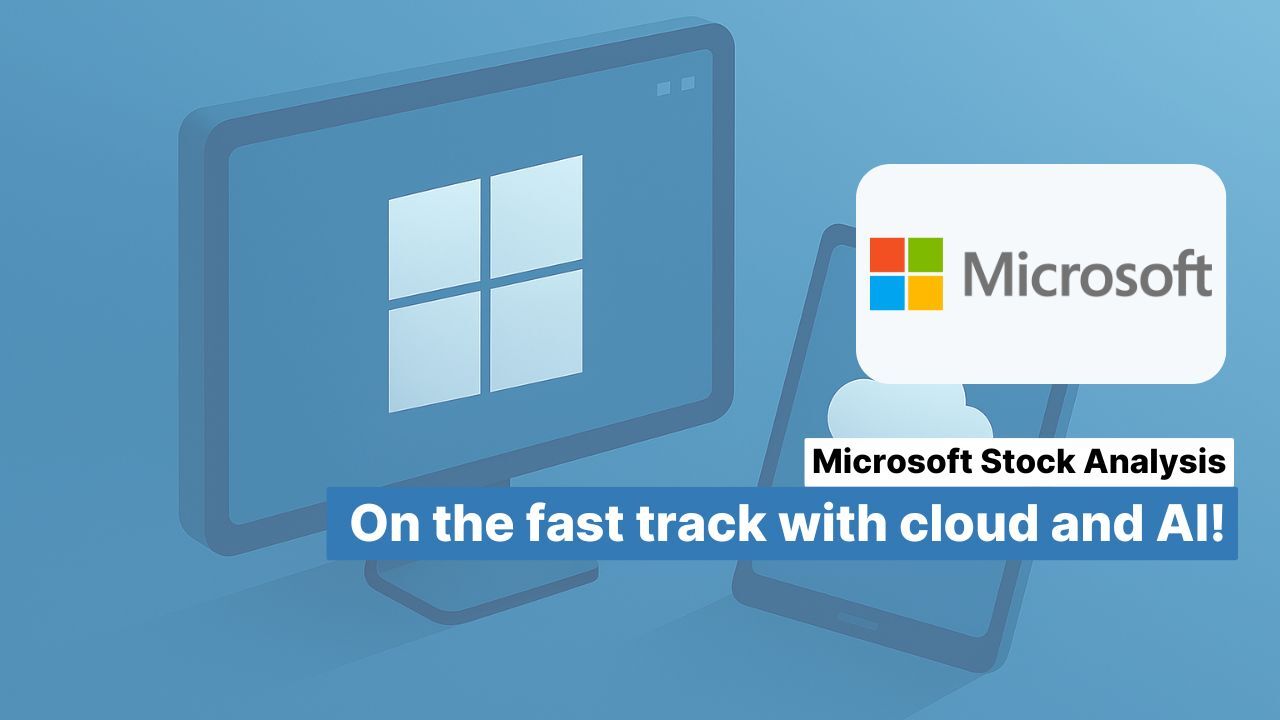Table of Contents
Microsoft stock (ISIN: US5949181045) remains one of the most successful stocks in the technology sector today. Over the past ten years, it has delivered impressive gains of around 1,000 percent to investors, thanks primarily to its continued success in the cloud and AI business. However, after the last major consolidation in 2022 and early 2025, the stock price repeatedly reached new all-time highs. The stock is currently trading at around $514, which corresponds to a market capitalization of over $3.8 trillion.

Source: Microsoft stock price
Nevertheless, the valuation remains ambitious. With a price-earnings ratio of around 38, Microsoft is not a bargain, but rather a quality stock from which investors expect strong and sustainable growth. This confidence is not unfounded: the company has been growing steadily for years, driven by the Azure platform, Microsoft 365, and now the increasing integration of artificial intelligence into almost all product lines. The latest quarterly figures once again confirmed the group's operational strength and high profitability. Whether the stock is still a buy at its current level ultimately depends on the investment horizon. In the short term, the high valuation level could have a dampening effect on returns. In the long term, however, Microsoft is likely to be an attractive core value for any technology portfolio thanks to its innovative strength, financial strength, and market leadership in the cloud and AI sectors. Find out more in the Microsoft stock analysis.
💡 In a nutshell
- Microsoft is a financially strong and profitable company with a strong position in the cloud, AI, and software sectors.
- The stock is highly valued; strong growth is necessary to justify the current price level.
- In the long term, Microsoft offers stable prospects for investors, particularly through continuous dividend increases and strong moats.
Business model: What does Microsoft do?
Microsoft is the world's leading diversified software company. Its market capitalization of just under $3.8 trillion illustrates the size of the company. It is difficult to imagine achieving such capitalization with a pure software product. And indeed, Microsoft has much more to offer than just a software product. It originally grew big with the Windows operating system and the Office suite. Distribution via new computers worked perfectly.
Over the years, Microsoft then developed into a powerhouse in the technology sector. Numerous acquisitions were made, which put the company on a broader footing. The leap into the cloud was also extremely successful. Directly behind market leader Amazon, Microsoft could take a clear lead ahead of Google Cloud. Last but not least, its partnership with OpenAI secured it a leading position in the race for generative chatbots and the chance to be the first of the big tech companies to achieve superintelligence. According to the agreement, Microsoft is entitled to 49 percent of the profits of OpenAI's for-profit subsidiary.
Despite the growing importance of AI, Microsoft currently still divides its business into three divisions:
- Productivity and Business Process,
- Intelligent Cloud, and
- More Personal Computing.
The last segment encompasses the original core business and hardware activities in the PC market. Gaming activities are also included here. The More Personal Computing division has grown at a below-average rate in recent years. It received a boost from the acquisition of game developer Activision-Blizzard. In recent years, the Azure cloud has been the growth driver in the business. The associated “Intelligent Cloud” business area is already the dominant division of the group and is recording the highest growth rates within the group. However, the most profitable segment is Productivity and Business Processes. It includes all products and services that help companies and individuals work more productively and make business processes more efficient. These include Microsoft 365 (with Office, Teams, Outlook, etc.) for communication and collaboration, Dynamics 365 for business processes such as sales, finance, and customer management, and LinkedIn as a professional network. In addition, Microsoft offers tools for data analysis, process automation, and app development with the Power Platform (Power BI, Power Apps, Power Automate). The goal of this division is to improve collaboration, digitize workflows, and enable data-driven decisions.
Microsoft's latest quarterly figures from June 2025
Microsoft once again achieved very strong results in the most recent quarter and grew in almost all areas. Specifically, revenue in the fourth quarter of 2025 (quarter end: June 30, 2025) increased by 18 percent to US$76.4 billion. EBITDA increased by a third, while net profit also rose disproportionately by 24 percent to $27.2 billion.

Source: Microsoft financial data
The cloud business performed particularly well, continuing to prove itself as the most important growth driver. Azure and the Microsoft cloud as a whole posted double-digit growth – a clear sign that the massive investments in artificial intelligence and cloud infrastructure are bearing fruit. Microsoft 365 and Dynamics also showed solid growth, underscoring strong demand in the enterprise environment. Another encouraging sign is that the search and advertising services business and Xbox content continue to grow, demonstrating that Microsoft is increasingly successful beyond its core software business. By contrast, the traditional PC-related business was less dynamic. Although Windows and device sales increased slightly, they lagged behind the growth momentum of other divisions. LinkedIn also showed only moderate growth, indicating a more difficult environment in the advertising market and in terms of personnel demand.
Microsoft stock forecast for 2026
However, looking at 2025 as a whole, it is clear that Microsoft remains on an impressively stable growth path. With revenue growth of 15 percent and another disproportionately high increase in its operating margin, the software giant has further consolidated its position as one of the most profitable tech companies in the world. The outlook is positive, as Microsoft will continue to benefit from its consistent focus on cloud and artificial intelligence in the new 2026 fiscal year. The integration of AI features in nearly all product areas – from Microsoft 365 to Azure to developer tools – should continue to drive demand and boost revenue and profits. In addition, partnerships and investments in its own data centers show that the company is specifically expanding its infrastructure for further growth. It remains to be seen how this will affect profitability. In general, the high pace of investment in AI and cloud expansion is weighing on the cost structure in the short term. In submarkets such as PC hardware and online advertising, however, the environment is likely to remain volatile. Nevertheless, the strategic direction appears clear and sustainable in the long term – Microsoft is entering the new 2026 financial year with strong momentum and a broad positioning.
Analysts agree. They estimate revenue of USD 329 billion for 2026, with a slightly lower net margin of 35.7 percent.

Source: Sales and Margin forecast
Analysts' revenue forecasts for Microsoft show continued strong but increasingly differentiated growth in the coming years. After a sharp rise in 2026 and 2027, driven primarily by continued growth in the cloud and AI business, analysts expect momentum to level off somewhat from 2029 onwards. A phase of more mature growth could set in. By 2032, however, revenue is expected to rise to around $607 billion, more than doubling compared to 2025. The strongest growth is still expected to come from cloud services (Azure, Microsoft 365, Dynamics) and artificial intelligence. These segments are likely to make the largest contribution as companies and public institutions continue to modernize their digital infrastructures and increasingly integrate AI solutions into everyday life. The slight slowdown in growth around 2029/2030, on the other hand, could indicate market saturation in some sub-sectors, such as traditional software subscriptions or the hardware business. However, the subsequent recovery in growth rates until 2032 indicates that new innovation cycles – for example, through generative AI, new cloud models, or the expansion of global data centers – will provide fresh impetus. In the long term, Microsoft is thus positioning itself as a broadly diversified technology provider that is increasingly basing its revenue growth on recurring, high-margin cloud and AI services and has solid prospects for average double-digit growth rates.
How attractive is the Microsoft stock?
Despite a temporary slowdown in momentum, Microsoft stock remains a core investment in the technology sector. The software giant continues to benefit from its strong market position in the areas of cloud, artificial intelligence, and software. The Azure platform in particular is a key growth driver: with double-digit growth rates and ever closer integration with AI services such as Copilot, it is helping Microsoft to gain further market share in the cloud business. The other business areas are also performing solidly. The integration of Activision Blizzard has given the “More Personal Computing” division fresh impetus, particularly in the gaming segment around Xbox and Game Pass. At the same time, the advertising and search business via Bing is contributing increasingly to revenues, thereby reducing Microsoft's dependence on traditional software revenues.

Source: Financial Data
With over $90 billion in cash reserves, Microsoft also has an exceptionally strong financial base. This allows the company to continue investing in data centers, AI infrastructure, and strategic acquisitions without encountering any major financing problems. As in the past, potential major acquisitions could lead to potential jumps in revenue. However, the current focus is clearly on expanding its own AI ecosystem and strengthening existing platforms.
Valuation of Microsoft stock
However, investors should bear in mind that Microsoft stock is now very ambitiously valued. With a current price-earnings ratio (P/E) of around 38, the stock is valued significantly higher than the industry average. The ratio shows that investors continue to place strong emphasis on future growth and sustained high margins. However, given the recent solid but not outstanding sales growth, caution is also advised. Anyone buying the stock is paying a premium for quality – but possibly too much.

Source: Key metrics
The dividend yield is currently around 0.6 percent, which is relatively low. This is typical for a growth-oriented technology company that invests most of its profits in research, development, and now also in infrastructure. The low payout ratio of around 25 percent reflects this to a certain extent. However, it also shows that Microsoft still has plenty of scope to increase its dividend further in the future without jeopardizing its financial stability. Over the past five years, the group has increased its dividend by an average of around ten percent per year – an impressive level of continuity that also appears realistic for the coming years.

Source: Dividend history
However, this is not enough to earn it the status of a top dividend scorer. Only in the Levermann analysis does the Mag7 stock currently perform convincingly.

Source: Stock analysis
A closer look at the Levermann criteria reveals particular strengths. For example, the analysis shows that Microsoft is an extremely solid company with very strong fundamentals. It impresses with high profitability, a healthy balance sheet, and stable earnings growth. The stock price performance in recent months also points to sustained positive market sentiment.

Source: Levermann analysis
However, the valuation suggests that many of these positive aspects are already reflected in the stock price. The stock is currently considered expensive and analysts' opinions are predominantly optimistic, leaving little room for additional surprises. In addition, the latest earnings forecasts do not indicate any further increases, which may suggest that growth has peaked.

Source: Microsoft target price
Meanwhile, analysts seem to be focusing on future potential, with 93 percent of them recommending buying the stock. Only five out of 70 analysts recommend selling. However, due to the high valuation, the valuation risks are high. Disappointing growth could quickly trigger corrections. On the other hand, the AI fantasy could still trigger a special dynamic. In the long term, the stock is likely to remain an interesting investment. With the same growth prospects, one could consider entering the market with a risk buffer at a price-earnings ratio in the mid-20s. A P/E ratio alert of 28 would be a signal to take another close look at the stock.
🔔 If you would like to receive weekly investment ideas and free stock analyses selected according to the Levermann, high-growth investing, or dividend strategies by email, you can subscribe to our free StocksGuide Insider now.
The author and/or persons or companies associated with StocksGuide own or may own shares of Microsoft. This article represents an expression of opinion and does not constitute investment advice. Please note the legal information.




